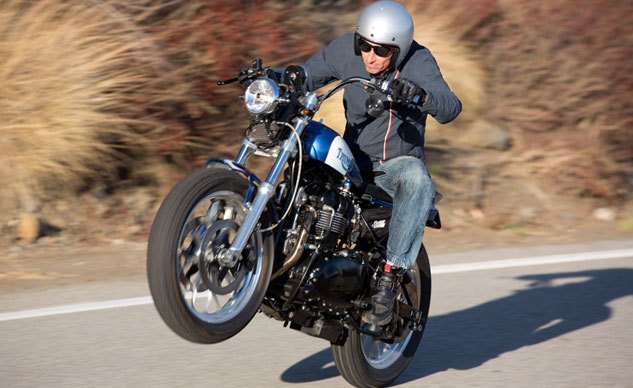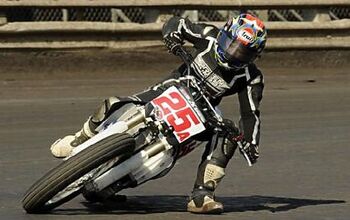2013 Bonneville Performance Street Tracker Review
From the dirt-track races to your garage!
If you believe modern motorcycles are too mild-mannered and polite, you’ll be interested in reading about Bonneville Performance’s wild and wooly Street Tracker. It’s a grin factory and a heart attack on two wheels, boasting mega power and a stripped-down lightweight chassis, a package not far removed from the legendary vintage Triumph dirt-trackers ridden by Gene Romero and the dearly departed Gary Nixon.
Bonneville Performance is a business designed around racing at the top level of dirt-track competition, bringing back the storied Triumph name to its old American stomping ground. The Florida-based team is guided by team principal Bill Gately, a guy with decades-long roots in dirt tracking
“We were a family Triumph-powered team in the ’70s, and it was a major blow to see the brand that once dominated virtually disappear,” Gately tells us. “It has been my dream for my second career to bring the brand back to Grand National Flat-Track Racing.”
2012 AMA Flat Track Season Finale – Video
And so Gately has been back in the business of developing a Triumph-based dirt-tracker, beginning back in 2005. Gately and BP have been developing its racebike around an enlarged Triumph parallel-Twin engine. The 995cc powerplant employs the 270-degree crank used in Triumph’s cruiser models instead of the Bonneville’s 360-degree crank, as it tends to mimic a V-Twin’s power pulses so it hooks up better off the corners.
If that sounds like a recipe for a dream bike, Gately’s got a street-legal version he’s bringing to market. And he was gracious enough to hand us the keys for a day of blasting around on this dirt-tracker with lights.
How Cool?
Cool enough that John Kocinski, the mercurial former dirt-track star who graduated to the 1990 250 GP world title and the 1997 World Superbike championship, gave it a good, long, loving look while I hopped on to take it out for a spin. It’s difficult to excite a racing legend, but Kocinski clearly liked what he was looking at.
Impressing a two-time world champion roadracer comes at a price, starting at a fairly lofty $24,500 with the original 865cc engine hogged out from 90mm to 92mm to displace 904cc with the stock 68mm stroke. With hotter cams, minor head work and a pipe, Gately says it transmits 82 horses to the rear wheel, a massive boost from the 62 horses the stock Thruxton kicked out during our comparison test with Moto Guzzi’s V7 Racer. Torque is bumped from 53 to 68 ft-lb. Four additional horses can be unleashed by removing the bike’s counter-balancer, but the engine will then lack smoothness. Gately says more than 90 rwhp can be had with the counter-balance system by using a special cam grind he offers.
As you might expect from a race shop, engine permutations are numerous and limited only to the size of your checkbook. But anything bigger than the 904cc lump is delivered without a counter-balancer system. A 995cc version, same as the racebike to fit under the 1000cc limit for air-cooled Twins in the AMA Flat-Track Championship, is available for an extra grand. Both it and a 1090cc-engined Tracker list for $25,500.
The liter-size version can be set up with a usable 10.5:1 compression ratio for street use. Racers will appreciate the option of equipping it with a stratospheric 13.5:1 compression ratio, a total-loss ignition and mechanical timing advance for the utmost in performance. Gately says it produces 101 rear-wheel horsepower and 88 ft-lb of twist.
But if you’re greedy for power, upping to $26,500 will get you an 1191cc monster (via a 101mm bore and extended 74.3mm stroke). Gately purports a healthy 104 horses at the rear wheel and a stout 92 ft-lb of torque. And if you’re intensely gluttonous for power, BP has a hotter cam that replaces the factory grind to net an additional 10 ponies.
Supporting whichever engine you choose is a 4130 cro-moly steel tube frame and swingarm designed by Bonneville Performance for its dirt-track racers. Thin tubing (0.095-inch) and minimal equipment result in a 351-pound package with its 2.4-gallon dirt-track-style fuel tank full.
The bike’s wheelbase can be adjusted from 55.5 inches to 57.5 inches depending on your choice between ultra-nimble or more stable, which combines with a modest 24.5-degree rake angle via a 43mm fork from an older Yamaha R6. Rear suspension is via a Penske shock, three-way adjustable like the fork. Billet triple clamps offer a variety of offsets to further tune steering geometry to your tastes. Wheels are 19-inchers front and rear.
Gately emphasizes that his bikes can be custom tailored to its owner with a variety of build specs.
“It is my experience that each rider and potential buyer has their own preferences, and as a builder, I do my best to meet all of these if possible,” Gately explains. “Each Tracker I build is customized to the buyer’s preferences, right down to his or her inseam.”
Fired Up
Dual fuel petcocks are a throwback to an earlier era, funneling fuel to a pair of Mikuni flat-slides between your knees. In fact, the whole bike, aside from the brakes, feels like a regurgitation of a vintage machine. The Tracker we rode, Gately’s personal bike, wasn’t even fitted with a speedometer.
The Tracker’s seat, placed at 31.5 inches, demonstrates a racer’s minimalistic design ethos. It’s roomy enough and has a handy bolster that keeps a rider in place when the inevitable wheelies occur, but the seat foam density is just to the soft side of a two-by-four. The fairly wide and tall handlebar position allows an easy reach and terrific leverage for easy steering transitions.
For a hot rod such as this, I wasn’t surprised that BP’s Tracker needed a bit of coaxing to light up and to maintain a steady idle. But the fence-rattling bellow of the big parallel-Twin makes patience worthwhile, cackling madly through a mildly baffled Supertrapp muffler mated to BP-designed headers.
Which Way To Springfield?
The Tracker’s grumpy nature is reinforced by heavy throttle springs and a stiff gearbox. And unlike a stock Triumph, neutral was difficult to access at a stop, seemingly due to excessive clutch drag. Also, the flat-slide carbs might deliver big power, but they don’t like small throttle openings such as when steady-state trolling at low speeds. But the experience of sitting astride an authentic dirt-track racer while on public roads makes such quibbles drift into the background.
However, one characteristic that won’t be forgotten was the monumental weaving while riding over rain grooves at freeway speeds. It was so bad at one point that, out of sheer fright, I was forced to pull over into the slow lane. My guess is that the open-block tread of the Maxxis dirt-track tires were causing the unwelcome steering weave, and neither a tight grip nor a relaxed grip would alleviate it. And without a vibe-reducing counter-balancer, the Tracker makes for a horrible sport-touring bike, which should be a surprise to no one.
The freeway trip had soured my impression of the Street Tracker, but the bike’s potential was realized as soon as I hit a twisty mountain road. Wide bars and light weight yield immediate steering responses, and the Tracker hungrily devoured each corner with brutal grace.
I quickly grew accustomed to sport riding this dirt-tracker, so much so that I began dragging hard parts – the kickstand on the left and, especially, the muffler on the right. Flat-track racers might not be required to make right turns, but a streetbike does. This hasn’t been a problem for Gately on Florida’s flat and straight roads, but he’s since adapted a new exhaust arrangement for anyone needing extra cornering clearance.
Pulling the flat-slide trigger revealed a monster, with a wide and sledgehammer-y hit that feels entirely unrelated to the docile nature of the bike’s donor engine. The stock engine is pleasant. The BP engine is wild and animalistic, the antithesis of pleasant, ferociously yanking the lightweight Tracker out of corners. Its fury is accentuated by a cacophonous roar rebounding off canyon walls.
Conclusion
Bonneville Performance’s Street Tracker isn’t just an homage to dirt-tracker competition, it’s an authentic racer with just enough equipment to make it street-legal – raw and unrefined relative to contemporary production bikes. Its freeway manners are atrocious, its seat is unyielding, and its motor is gruff and vibey. Most riders will find it too beastly.
But for that subsection of riders who believe nothing is more glorious than seeing a motorcycle broadsliding into a 100-mph flat-track cushion, there are few machines that can conjure up visions of dirt-track magnificence like BP’s Street Tracker. Like great sex, you’ll be breathing heavy after every ride.
For more information, visit the Bonneville Performance website.
+ Highs
- Authentic dirt-track experience
- Power far beyond its roots
- Lightweight and nimble
– Sighs
- Spendy
- Instability
- Vibration
More by Kevin Duke








































Comments
Join the conversation
Very cool bike. Check the latest edition of Cycle News for another Bonnie custom tracker by long time SoCal fixture South Bay Triumph. That bike is beautiful as well.
This type of bike is not about value for the money or function, it is about cool. Cool can't be objectively measured, it does not obey the laws of practicality. Cool just is. My buddy's modded out ex drag bike H2 750 is like that. A ruder but cooler bike I have never ridden. That H2 is an evil sharp hitting crackling 2 stroke kick in the pants!
By definition, something truly cool is not palatable or practical for everyday use by the masses. Would not want to commute every day on my friend's H2, that would be ridiculous. Can't think of a better bike to take to a bike night though. It draws a crowd every time, and the off kilter 2 stroke crackling exhaust note emanating from the Fast By Gast pipes and too small silencers is something Satan would no doubt appreciate.
This little 'tracker is that kind of bike.
Would love to have the kind of money one would need to keep a bike like this around as a secondary ride and something to look at just sitting in the garage.
Great story Dukey! Love the hipster-helmet.